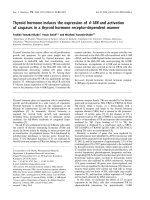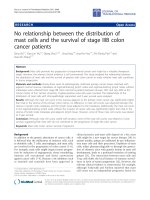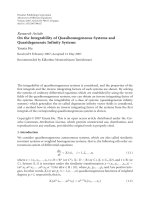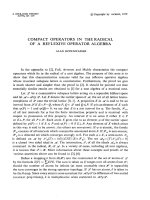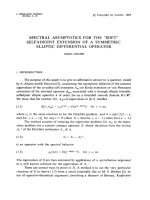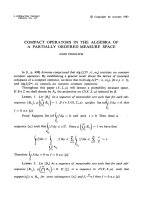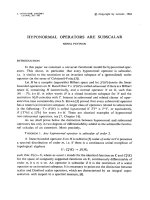Báo cáo toán học: " Permutations which are the union of an increasing and a decreasing subsequence" doc
Bạn đang xem bản rút gọn của tài liệu. Xem và tải ngay bản đầy đủ của tài liệu tại đây (110.23 KB, 13 trang )
Permutations which are the union of an
increasing and a decreasing subsequence
M.D. Atkinson
School of Mathematical and Computational Sciences
North Haugh, St Andrews, Fife KY16 9SS, UK
Abstract
It is shown that there are
2n
n
−
n−1
m=0
2
n−m−1
2m
m
permutations
which are the union of an increasing sequence and a decreasing se-
quence.
1991
Mathematics Subject Classification
05A15
Submitted: December 1, 1997; Accepted: January 10, 1998
1 Introduction
Merge permutations
, permutations which are the union of two increasing
subsequences, have been studied for many years [3]. It is known that they
are characterised by the property of having no decreasing subsequence of
length 3 and that there are
2n
n
/
(
n
+ 1) such permutations of length
n
.
Recently there has been some interest in permutations which are the union
of an increasing subsequence with a decreasing subsequence. We call such
permutations
skew-merged
. Stankova [4] proved that a permutation is skew-
merged if and only if it has no subsequence
abcd
orderedinthesamewayas
2143 or 3412. In [1, 2] the more general problem of partitioning a permutation
into given numbers of increasing and decreasing subsequences is considered.
1
the electronic journal of combinatorics 5 (1998) #R6 2
y
x
Figure 1: The graph of a skew-merged permutation
This paper solves the enumeration problem for skew-merged permutations.
The proof yields another proof of Stankova’s result. Finally, a corollary allows
the skew-merged enumeration result to be compared with the enumeration
of merge permutations.
2 Points and colours
Weshallconsidersetsof‘points’(a, b)inthe(x, y)-plane. Our point sets
will always have the property that there is no duplicated first coordinate
or second coordinate. In view of that condition there are two natural total
orders on points. If P =(a, b)andQ =(c, d) are points then we define P Q
if a<cand P<Qif b<d.
Two sets of points S, T are said to be order isomorphic if there is a one-to one
correspondence between them which respects both total orders. A set of n
points is called normal ifitssetsofx-coordinates and y-coordinates are each
{1, 2, ,n}. It is easy to see that every set of points is order isomorphic to a
unique normal set. Note that a point set corresponds to a poset of dimension
2.
Every permutation σ =[s
1
, ,s
n
] defines and is defined by a normal set
{(i, s
i
)}
n
i=1
and we shall find it helpful to depict a permutation by its set of
points plotted in the (x, y)-plane. If the permutation is skew-merged this
graph looks like Figure 1 where the increasing and decreasing subsequences
are clearly visible. In the terminology of dimension 2 posets, an increasing
subsequence is a chain and a decreasing subsequence is an anti-chain.
the electronic journal of combinatorics 5 (1998) #R6 3
There are three involutory symmetry operations r, s, t on point sets and per-
mutations defined on the points P =(a, b)ofapermutationσ of length n as
follows
r(P )=(n +1− a, b)
s(P )=(a, n +1− b)
t(P)=(b, a)
We let r(σ),s(σ),t(σ) be the corresponding permutations and note the fol-
lowing elementary result:
Lemma 1 (i) If P, Q are points of the permutation σ, then P Q if and
only if r(Q) r(P ) in r(σ) if and only if s(P) s(Q) in s(σ) if and only
if t(P ) <t(Q) in t(σ)
(ii) σ is skew-merged if and only if any or all of r(σ),s(σ),t(σ) are skew-
merged.
If P is one of the points in the set P of points of the permutation σ then
P\P is a set of points with no duplicate first or second coordinates and
therefore it corresponds to some permutation τ and we write
τ = σ − P
This corresponds to removing one of the components of σ =[s
1
, ,s
n
]and
relabelling and renumbering the remaining components appropriately.
We divide the points of a permutation σ into 5 classes Red, Blue, Green,
Yellow, and White by the following rules:
(r) if P Q R and Q<R<P then P is red
(b) if P Q R and Q<P <Rthen R is blue
(g) if P Q R and P<R<Qthen P is green
(y) if P Q R and R<P <Qthen R is yellow
(w) if P is not red, blue, green or yellow, then P is white
the electronic journal of combinatorics 5 (1998) #R6 4
red blue
green yellow
white
y
x
Figure 2: Disposition of colours
There is a more convenient way of expressing these conditions. If P, Q, R are
any 3 points and [a, b, c]isanypermutationof1, 2, 3 then we write PQR ∼
abc if P Q R and, with respect to “<”, P, Q, R are ordered in the same
way as a, b, c. The premises of (r), (b), (g), (y) above are then PQR ∼ 312,
PQR ∼ 213, PQR ∼ 132, PQR ∼ 231 respectively. We also adopt this
language for sets of 4 or more points. For example, if P, Q,R, S are 4 points
such that P Q R S and Q<P <S<Rwe would write PQRS ∼ 2143.
The aim of this section is to prove the following
Theorem 1 The graph of a skew-merged permutation has the form shown
in Figure 2. In this figure the vertical and horizontal lines have the obvious
separation meaning; for example, if R and W are red and white points we
would have R W and W<R. Furthermore, the green and blue points are
increasing, the red and yellow points are decreasing, and the white points are
either increasing or decreasing.
In proving this theorem we shall use only the property of skew-merged per-
mutations that they avoid 3412 and 2143; in our ‘point’ terminology this
means that there do not exist 4 points P, Q, R, S with PQRS ∼ 3412 or
PQRS ∼ 2143. Since a permutation with a graph of the above form is
evidently skew-merged we obtain another proof of Stankova’s result.
Lemma 2 Let P be a point of a permutation σ. Then
(i) P is red in σ if and only if r(P ) is blue in r(σ)
the electronic journal of combinatorics 5 (1998) #R6 5
(ii) P is green in σ if and only if r(P ) is yellow in r(σ)
(iii) P is red in σ if and only if s(P ) is green in s(σ)
(iv) P is blue in σ if and only if s(P ) is yellow in s(σ)
(v) P is red in σ if and only if t(P ) is yellow in t(σ)
(vi) P is green in σ if and only if t(P ) is green in t(σ)
(vii) P is blue in σ if and only if t(P ) is blue in t(σ)
(viii) P is white in σ if and only if any or all of r(P ),s(P ),t(P) are white
in r(σ),s(σ),t(σ) respectively.
Proof All the statements follow easily from the definitions. For example,
suppose that P is red in σ so that there are points Q, R with PQR ∼ 312.
Then r(P ),r(Q),r(R)arepointsofr(σ)withr(R)r(Q)r(P ) ∼ 213; therefore
r(P )isblueinr(σ)
Lemma 3 In a skew-merged permutation σ every point has exactly one colour.
Proof Suppose first that a point P is coloured both red and green in σ.
Then there are points Q, R, S, T with P Q R, P S T, Q<R<P,and
P<T<S. In particular, Q<R<P <T <S.IfQ S then PQST ∼
2143, a contradiction, and if S Q then PSQR ∼ 3412, also a contradiction.
It now follows from the symmetry operations and Lemma 2 that P cannot
be coloured both blue and yellow (or r(P ) would be both red and green in
r(σ)); nor can P be both yellow and green (or t(P) would be red and green
in t(σ)); nor can P be both red and blue (or t(s(P ))wouldbebothredand
green in t(s(σ))).
Suppose next that P is both red and yellow in σ. Then there are points
Q, R, S, T with P Q R, S T P, Q < R < P ,andP<S<TBut then
STQR ∼ 3412. The remaining possibility, that P is both blue and green,
canalsobeexcludedbysymmetry(r(P ) would be red and yellow in r(σ)).
Lemma 4 If σ is skew-merged and P S are points of σ then
the electronic journal of combinatorics 5 (1998) #R6 6
(i) if P, S are both red or both yellow then S<P
(ii) if P, S are both blue or both green then P<S
Proof Suppose that P, S are both red. Then there are points Q, R, T,U
with P Q R, S T U, Q<R<P,andT<U<S. Suppose, for a
contradiction, that P<S. Then, since P S T U and PSTU ∼ 3412 we
must have P<U.Also,S Q is impossible, otherwise PSQR ∼ 3412. But
now PQSU ∼ 2143 which is the required contradiction.
Suppose next that P, S are both yellow. Then, as P S, t(P ) <t(S)in
t(σ)andt(P ),t(S) are red in t(σ). But we have just seen that this means
t(S) t(P)int(σ)andthereforeS<Pin σ.
Forpart(ii),ifP, S are both blue (green) then s(P ),s(S) are both red
(yellow) and s(P ) s(S). So, by part (i), s(S) <s(P ) and therefore P<S.
Lemma 5 Suppose that σ is skew-merged with points R, B, G, Y coloured
red, blue, green, yellow respectively. Then
(i) R Y (ii) G B (iii) G<B (iv) Y<R
(v) R B (vi) G Y (vii) G<R (viii) Y<B
Proof Since R is red and Y is yellow there are points S,T, U, V with R S T,
U V Y , S<T<R, Y<U<V. Suppose that Y R.Theneither
(a) T<Uin which case UV ST ∼ 3412, or
(b) U<Tin which case UY RT ∼ 2143
This contradiction proves that R Y .
Symmetry arguments prove relations (ii), (iii), and (iv). Thus, since s(G)is
red and s(B)isyellowins(σ), we have s(G) s(B) and therefore G B.Next,
since t(R),t(B),t(G),t(Y ) are yellow, blue, green, red respectively, we have
t(Y ) t(R)andt(G) t(B)int(σ)andsoY<Rand G<Bin σ.
To prove part (v) we consider two points X, Z such that XZB ∼ 213 which
exist since B is blue. Suppose that B R. Then either
the electronic journal of combinatorics 5 (1998) #R6 7
(a) T<Xin which case XBST ∼ 3412, or
(b) X<Tin which case XZRT ∼ 2143
This contradiction proves that R B and, as before, symmetry arguments
justify the other relations.
These lemmas have proved that the disposition of the red, blue, green, and
yellow points in the graph of a skew-merged permutation σ is as given in
Theorem 1. The next two lemmas show that the white points are disposed
as claimed.
Lemma 6 If R, B, G, Y are points of colour red, blue, green, yellow in a
permutation, and P is a white point, then
(i) R P (ii) G P (iii) P B (iv) P Y
(v) G<P (vi) Y<P (vii) P<R (viii) P<B
Proof Since R is red there are two points S, T with RST ∼ 312. If P R
then either T<Pin which case PST ∼ 312 so P would be red, or P<T
in which case PRT ∼ 132 and P would be green. All the other statements
follow by symmetry.
To complete the proof of Theorem 1 we have
Lemma 7 The white points of a permutation are either increasing or de-
creasing.
Proof From the definitions of red, blue, green, yellow every triple A B C
of white points must satisfy ABC ∼ 123 or ABC ∼ 321. Since every triple
is either increasing or decreasing the lemma follows.
3 Enumeration
In this section we use Theorem 1 to derive the following theorem.
Theorem 2 The number of skew-merged permutations of length n is
2n
n
−
n−1
m=0
2
n−m−1
2m
m
the electronic journal of combinatorics 5 (1998) #R6 8
To prove this we enumerate the skew-merged permutations according to their
number of white points. Let t
i
(n) denote the number of skew-merged per-
mutations of length n with exactly i white points.
Lemma 8
n
i=0
(i +1)t
i
(n)=
2n
n
Proof Suppose that σ is skew-merged and let α, β be a pair of increasing
and decreasing subsequences whose union is σ.LetA, B be the sets of points
of α, β. Consider a red point R and let S, T be the corresponding points
satisfying R S T and S<T<R. Suppose that R ∈A. Then, since R S
and S<R, S cannotalsobelongtoA. Therefore S ∈Band, similarly,
T ∈B. However, S T and S<Tand this is a contradiction. Therefore all
red points belong to B. By a similar argument all yellow points belong to B
also, and all blue and green points belong to A.
Suppose that σ has i white points which, without loss in generality, we shall
suppose are increasing. Then at most one of the white points can belong to
B. It follows that there are at most i + 1 possibilities for the pair (α, β) and,
by Theorem 1, all of these possibilities do indeed yield a pair of increasing
and decreasing subsequences whose union is σ.
The left-hand side of the equation in the lemma therefore counts the number
of increasing, decreasing pairs (α, β) whose union is a skew-merged permu-
tation. However, we can count these in another way. If |α| = r we may
choose the first components of the points of A in
n
r
ways and, indepen-
dently, the second components in
n
r
ways also. So the number of (α, β)
pairsistherefore
n
r=0
n
r
2
=
2n
n
Lemma 9
n
i=1
t
i
(n)=
2n−2
n−1
Proof The left-hand side of the equation in the lemma is the number of
skew-merged permutations with at least one white point. These permutations
are exactly those which are the union of an increasing subsequence α and a
decreasing subsequence β thathaveacommonpoint.Insuchapermutation
(σ,say)α is a maximal increasing subsequence and β is a maximal decreasing
the electronic journal of combinatorics 5 (1998) #R6 9
Figure 3: Young tableau
subsequence. It follows that the pair of Young tableaux which correspond, in
the Robinson-Schensted correspondence, to σ areshapedliketheoneshown
in Figure 3.
Conversely, every such pair of Young tableaux corresponds to a skew-merged
permutation with at least one white point. By the hook formula [3] §5.1.4,
the number of such tableaux with exactly r cells in the first row is
n!
n(r − 1)!(n −r)!
=
n − 1
r − 1
and hence the number of tableaux pairs is
n
r=1
n − 1
r − 1
2
=
2n −2
n − 1
Note that skew-merged permutations with no white points correspond to
Young tableau pairs with a shape similar to Figure 3 but with a cell in the
(2, 2) position. Unfortunately, not every Young tableau pair of this form
gives a skew-merged permutation.
Lemma 10 For all i>2, t
i
(n)=t
i−1
(n − 1)
Proof Suppose that σ is a permutation of length n with i white points.
Then, by Theorem 1, σ −W is independent of W provided only that W is a
white point of σ.Sincei>2 the deletion of W cannot change the colour of
any point of σ and so σ − W has i −1 white points.
Conversely, suppose that τ is of length n −1withi − 1 white points which,
since i>2 are either increasing or decreasing but not both. Then there is
the electronic journal of combinatorics 5 (1998) #R6 10
a unique permutation σ with i white points such that σ − W = τ for some
white point W of σ. This one to one correspondence proves the lemma.
Lemma 11 Suppose that σ is a skew-merged permutation with either one
white point (or no white points). Then there exist points R, B, G, Y with
colours red, blue, green, yellow such that either
(i) RGW BY ∼ 41352 (or RGBY ∼ 3142)andW is the only point (or
there is no point) in G W B,or
(ii) GRW Y B ∼ 25314 (or GRY B ∼ 2413)andW is the only point (or
there is no point) in R W Y
Proof Choose red, blue, green, yellow points R, B, G, Y so that R, G are
largest of their colour with respect to “ ”andB,Y are smallest of their
colour (equivalently, G, Y are largest of their colour under “<”andR, B are
smallest of their colour). According to Theorem 1, R, B, G, Y are ordered
under “ ”asR G B Y , R G Y B, G R B Y ,orG R Y B. Similarly
there are four possible ways in which they can be ordered under “<”.
Consider the ordering R G Y B.SinceG is green there are points P, Q
with G P Q and G<Q<P.NotbothP, Q canbebluesincetheblue
points are increasing, and nor, by hypothesis, can both be white. Further,
neither can be red or green since R G and R and G are the maximal red and
green points under “ ”. Thus at least one of them, P say is yellow. Since the
yellow points are decreasing and Y is the smallest yellow point under “ ”we
have Y P or Y = P,andsoG<P ≤ Y . Byasimilarargumentbasedon
the condition that Y is yellow we can deduce that Y<G, a contradiction.
Thus R G Y B is impossible.
The symmetry conditions now also exclude the possibilities G R B Y and
also G<Y <B<R,andY<G<R<B.
Suppose next that R G B Y and Y<G<B<R.SinceG is green there
are points G P Q with G<Q<P.SinceY<G, P and Q cannot be
yellow and so they must be white or blue with not both white; it follows that
P<Q, a contradiction. Finally, symmetry rules out the case G R Y B,
G<Y <R<B.
The remaining cases are
the electronic journal of combinatorics 5 (1998) #R6 11
(i) R G B Y and G<Y <R<B
(ii) G R Y B and Y<G<B<R
In case (i) a single white point W must, by Theorem 1, satisfy G W B and
Y<W<Rso that RGW BY ∼ 41352 giving the first alternative of the
lemma. Case (ii) gives the second alternative.
Lemma 12 t
1
(n)=t
0
(n − 1)
Proof Suppose σ is of length n and has exactly one white point. Let
R, B, G, Y be the points guaranteed by the previous lemma. If we remove
thesinglewhitepointweareleftwith4pointssuchthat
(i) RGBY ∼ 3142 with no point between G B or
(ii) GRY B ∼ 2413 with no point between R Y
These points remain coloured as they were (GBY ∼ 132 ensures G is green,
RGB ∼ 213 ensures B is blue etc) and so we have obtained a sequence with
no white points. Conversely, the last lemma shows that a sequence without
white points has this form for some R, B, G, Y .IfweinsertapointW
satisfying G W B and Y<W<Rin case (i) and R W B and G<W<B
incase(ii)thispointmustbewhite(asitispartofbothanincreasing
sequence and a decreasing sequence in a skew-merged decomposition, see the
proof of Lemma 8). We therefore have a one-to-one correspondence proving
that t
1
(n)=t
0
(n − 1).
Since t
n−i
(n) is independent of n if i ≤ n − 2 (Lemma 10) we may set
b
i
= t
n−i
(n) for all i ≤ n −2. Also, we let a
n
= t
0
(n)fromwhich,byLemma
12, we find t
1
(n)=t
0
(n − 1) = a
n−1
. Hence the number of skew-merged
permutations is
s
n
= t
0
(n)+t
1
(n)+ + t
n
(n)
= a
n
+ a
n−1
+ b
n−2
+ + b
0
Rewriting Lemmas 8 and 9 we obtain
a
n
+2a
n−1
+3b
n−2
+4b
n−3
+ +(n +1)b
0
=
2n
n
a
n−1
+ b
n−2
+ b
n−3
+ + b
0
=
2n − 2
n − 1
the electronic journal of combinatorics 5 (1998) #R6 12
These equations are easily solved. Differencing reduces them to a pair of
low order inhomogeneous linear recurrence equations to which the method
of generating functions may be applied. We obtain the generating function
∞
n=0
s
n
x
n
=
(1 − 3x)
(1 −2x)
√
1 −4x
from which we find
s
n
=
2n
n
−
n−1
m=0
2
n−m−1
2m
m
proving Theorem 2. Finally, we have an asymptotic result.
Corollary 1
s
n
2n
n
→ 1/2 as n →∞
Proof From Theorem 2 it follows that
s
n
=2s
n−1
+
n − 2
n
2n − 2
n − 1
In this equation we divide through by
2n
n
, and put r
n
= s
n
/
2n
n
to obtain
r
n
=
n
2n −1
r
n−1
+
n − 2
4n − 2
and take the limit as n →∞.
Acknowledgement I thank Dominic Tulley for several useful observations
during the course of this work.
References
[1] A. Brandst¨adt, D. Kratsch: On partitions of permutations into increas-
ing and decreasing subsequences. Elektron. Informationsverarb. Kyber-
net. 22 (1986), 263–273
the electronic journal of combinatorics 5 (1998) #R6 13
[2] A.E. K´ezdy, H.S. Snevily, C. Wang: Partitioning permutations into in-
creasing and decreasing subsequences, J. Combinatorial Theory A 74
(1996), 353–359.
[3] D.E. Knuth: Sorting and Searching (The Art of Computer Programming
volume 3), Addison Wesley, Reading, MA, 1973.
[4] Z. E. Stankova: Forbidden subsequences, Discrete Math. 132 (1994),
291–316
